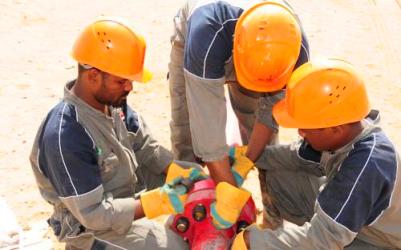Sudan’s oil ministry downplays radiation incident in W. Kordofan
June 15, 2014 (KHARTOUM) – Sudan’s oil ministry acknowledged on Sunday reports that foreign workers have been exposed to radiation at an oil facility in West Kordofan state attributing the incident to a common technical error.

He pointed in a press release seen by Sudan Tribune on Sunday that a radioactive device which is used for reading oil wells’ properties was left outside its designated area for three days, adding that prompt action was taken when the error was discovered.
Al-Taghyeer daily published in Khartoum reported yesterday that 70 workers were directly exposed for three consecutive days to the radiation emitted by a device called “Source.”
One of the engineers reportedly left the device used in oil exploration inside the workshop without properly securing it at its underground location which is 200 kilometers away from the workers.
The Chinese oil company urgently evacuated the workers to Khartoum in order to undergo medical tests.
One of the workers, who requested anonymity, told the newspaper that the first batch sent to Khartoum comprised of 21 workers including 13 Sudanese, 2 Pakistani and 6 Chinese.
He explained that the device remained at the workshop frequented by workers and engineers without any protection since six o’clock Friday evening until Monday evening. It was only discovered as missing by pure coincidence by a Chinese engineer after some other machines stopped working as a result from the device’s radiation.
Another worker disclosed that the impacted group consisting of technicians, engineers and guard are currently staying at a hotel in Khartoum at the expense of the company in the neighborhood of Riyadh while being tested. They are allowed to move but with restrictions to ensure that news of the incident does not get leaked before final results are released.
He said the manager of the private hospital, which is conducting the tests refused to write a report specifying the quantities the workers were exposed to under the pretext that this type of testing is not available noting that anything over 20 millisievert (mSv) a year can heighten risks of cancer.
But the Sudanese official said that only 28 workers including foreigners were immediately evacuated to Khartoum by a private jet.
He stressed that they underwent medical tests at two hospitals, adding that results showed that their health conditions are compromised by the radiation exposure.
Abu Al-Gasim revealed that the ministry formed a technical team comprised of three oil companies besides the National Intelligence and Security Services (NISS), saying the team managed to place the device back in its designated area.
He said the ministry also formed a joint team in coordination with scientific institutions to conduct a field survey to measure the radiation, stressing the reading was less than 60% of the acceptable radiation level.
The minister added that impact of the leak source did not exceed one meter, affirming that administrative procedures are underway and oil companies have resumed their work.
He underscored his ministry’s keenness to ensure workers’ safety through applying accurate and rigorous measures.
According to the World Nuclear Association (WNA), 20 mSv per year averaged over 5 years is the limit for radiological personnel such as employees in the nuclear industry, uranium or mineral sands miners and hospital workers.
But WNA says that 50 mSv is the lowest dose at which there is any evidence of cancer being caused in adults. It is also the highest dose which is allowed by regulation in any one year of occupational exposure.
(ST)
